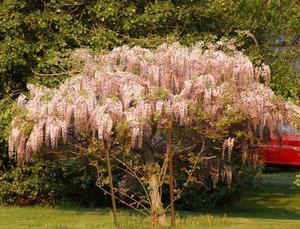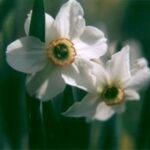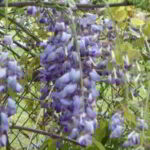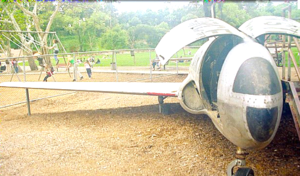The wisteria is a beautiful climbing vine that’s popular for its hanging clusters of fragrant flowers. Wisterias are available in several varieties, but it is the purple variety that usually comes to mind first. They put on a gorgeous display when they bloom in the spring. The wisteria is not a petite climber with delicate little tendrils. It’s wise to not underestimate the power of this exotic climber. Choose a wisteria’s location carefully.
The wisteria vine is part of the pea family (Fabaceae) which is noticeable in the green seedpods. These seedpods that indeed resemble beans follow the beautiful blooms of the wisteria. That is where the similarity ends. The seeds of the wisteria might look like beans, but they are poisonous, as are all parts of the plants. All varieties of wisterias are deciduous.
The wisteria’s twining vines are vigorous, hardy and can climb quite high. Some varieties can climb more than twenty-five feet and the vines can eventually become very thick, twisted and woody. Wisterias take years before they begin blooming, so patience is necessary.
If a wisteria has been grown from seed, it can take ten to fifteen years before it blooms. It won’t take as long if the plants have been grown from cuttings or are grafted. Some can begin blooming in about four years after planting, but most usually take seven years to bloom.
There are about ten types of wisterias with flowers in shades of purples, pinks and white. The flowers hang dramatically in clusters from six inches to three feet in length. The most popular in home gardens are the Japanese (Japanese floribunda) and Chinese (Wisteria sinensis) varieties.
The Japanese and Chinese are the showiest and most fragrant, but they are also the largest and most powerful of the wisterias. The vines of these varieties of wisteria can become heavy with age and they can damage structures, even houses. They need to be kept away from areas they can damage, such as gutters and spouts.
The Chinese wisterias have the flower clusters appear before the leaves emerge which makes the blooms more showy than other varieties. The individual flowers along the length of the clusters open all at once as well. This makes for a dramatic display of violet-blue fragrant flowers. There is also a Chinese variety ‘Alba’ that has very fragrant white blooms.
The Japanese and Chinese wisterias are hardy to USDA Zones 4 and five, but they grow more successfully in warmer regions. There are also two kinds of wisterias that are native to the United States. One of those varieties called ‘Kentucky’ is a better candidate for colder winters.
There is another reason to choose the location carefully for the wisteria vine. Once the plant has become established in its location, it doesn’t like to be moved. An old wisteria vine usually will not survive being transplanted to another place.
The best time to plant container-grown varieties of wisteria is in spring. The vine will need a location that receives at least six hours of sun a day and well-drained soil. Dig a hole two or three times bigger than the size of the root ball, and amend the soil with compost or peat moss. Water the wisteria thoroughly after planting and fertilize once a year. Mulch the base of the wisteria to help keep the soil evenly moist. Since the vine will not bloom for several years, the growth of the vines and leaves are being established at first.
Once the new wisteria is planted, it will be time to train the vine on a support-system or arbor. Choose the strongest upright stem that is growing the fastest. This will be the leader vine and it will be attached to the support first. Cut the other side shoots off the main vine at the bottom. As the leader vine grows, it will need to be trained upward on the support.
This main vine will begin growing side branches and these will need to be trained to the support as well. The more side branches that develop and grow, the more flowers the vine will one day have. Keep training the side branches to fill in the support. Leave about eighteen inches between the branches. Once the wisteria vine has grown as far as it needs to, cut the end of the leader vine off.
There are ways to keep the wisteria vine manageable. The size can be kept shorter with pruning, but it still needs a strong support system. A weak trellis or arbor will never hold the weight of the wisteria’s thick powerful vines after it ages. In fact, the wisteria vines become much more similar to a twisted tree trunk as it ages. It can even be trained to the shape and size of a small tree and they look beautiful in this style.
The wisteria will need a strong support stake to be trained to become a tree- form. The vine will need to be staked upright onto a sturdy pole. As the wisteria is growing, the side shoots are always removed to allow a trunk to form. The growth will only be at the top. Once the vine has reached about five feet in height, the top is cut. Always keep side shoots pruned off the “tree trunk” and allow the vines to branch at the top until it thickens and resembles a tree.
As soon as the flowering stops, the Oriental wisterias can be pruned to keep them shaped and control the size. This is really the only maintenance they need once they become established. If the wisteria is just left to grow unchecked, then it can take over the yard and possibly break the support structure. It’s worth spending a little time pruning the wisteria each year. The rewards will be beautiful flowers and a plant that will be with you for a long time.








